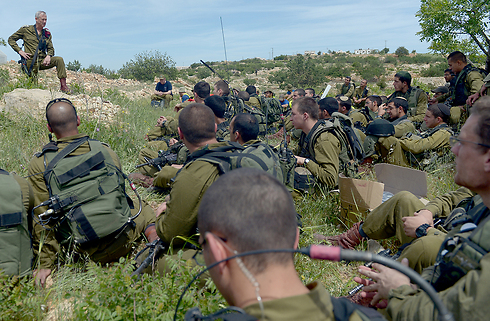Military simulates incidents spinning out of control and sparking a wider conflagration, and has established a number of principles in the event of an all-out uprising.
Widespread talk of a Third Intifada becoming reality is a fairly recent phenomenon on the Israeli street, but the IDF has spent years coming up with scenarios and contingency plans in the event of an escalation of terror.
In late July, a senior officer in the IDF Central Command said Palestinian President Mahmoud Abbas had a clear agenda against violence and was a stabilizing factor. Since the current wave of terrorism began, the defense establishment again said that Abbas is not an agitator.
Even so, the IDF’s Judea and Samaria Division has for two years been preparing for a series of worst-case scenarios in case of a “true Intifada”.
Despite the disturbances of the past two weeks, which were much more violent than similar disturbances in recent years, great masses of Palestinians have yet to go out to the streets.
Almost all new regional brigade commanders in the IDF start their tenure with a regimental exercise lasting about a week.
At the beginning of the year, the Judea and Samaria Division carried out a widespread General Staff exercise that simulated an all-out escalation.

Since 2011, the IDF has prepared for a third intifada more or less once a year, but every year the Palestinian street remained largely indifferent or stable, except in periods of violence such as during Operation Pillar of Defense and Operation Protective Edge.
The IDF’s response to extreme scenarios does not come only in the form of dozens of military exercises. There are also some key principles unerlying the contingency plans in the event of the outbreak of an all-out uprising:
• Instant deployment of thousands of regular fighters from training camps to regional divisions within 12 to 24 hours.
• Preserving the policy of containment during disturbances and minimizing Palestinan casualties, with a focus on using non-lethal means such as tear gas and rubber bullets.
• Junior and and mid-level officers, rather than soldiers, should be at the front and make decisions in dealing with the demonstrations.
• Proportionate use of curfews as needed and according to operational considerations only, while separating the Palestinian population from the terrorists.
• Widespread deployment of checkpoints during an alert of a terrorist attack or an escape of a terrorist.
• Prioritizing training and operational exercises for reserve battalions brigades, which will be quickly deployed during a significant escalation.
• Not tolerating, especially in the case of officers, incidents of violence by right-wing activists against Palestinians or soldiers, and arresting them until the police arrive.
Exercises simulate scenarios such as a car bomb detonating next to a bus full of Jewish schoolchildren, and a minibus full of European tourists accidentally encountering a violent protest in Bethlehem.
One exercise simulated 400 Palestinian rioters trying to attack the Jewish settlement in Hebron, while a terrorist shoots at Border Police as a diversionary ractic. In this simulation, forces had to surround Hebron in order to prevent the escape of the attack’s mastermind.
Another scenario dealt with the entrenchment of four terrorists with hostages in one of the Jewish settlements’ yeshivas.
In these exercises, the soldiers who trained were those who have faced riots, an phenomenon that is currently a daily occurrence.
As reported by Ynetews
